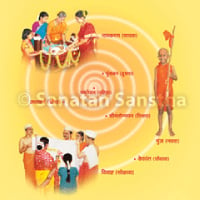Dharma preaches that the purpose of human birth is God-realisation. The religious scriptures therefore impart guidance on how to undertake spiritual practice so as to be able to get closer to God in every incident of life, right from birth till death. Sanskars should be performed to get closer to God in the sixteen rituals in life from conception to marriage. These sanskars later help in improving spiritual practice. The Vedic rituals performed by the mother, father and the Guru on the son or daughter from the time of conception till marriage, so that they may perform balanced sattvik (Sattva-predominant) actions are referred to as the sanskars. There are sixteen important sanskars. This article imparts information on the first three sanskars. These garbh sanskar are performed before the birth of an individual and contribute in begetting a virtuous progeny.
1. Garbhadhan (Rutushanti)
A. Importance
In this sanskar, body purification is achieved with the help of specific mantras and sacrificial fires and through the mantras it is taught how to scientifically and hygienically perform correct intercourse. Necessary guidance is imparted on various sexual matters like reproduction of good offspring, appropriate use and control of sexual desire, not to indulge in sex during the menstrual cycles, various postures at the time of sex and highest happiness etc.
B. Objectives
-
In the 8th chapter of Bhagvat, there is a mention of ‘Payovrat’. Its essence is that from the point of view of giving birth to a child, the couple that is very particular about a restrained life, sattvik meals and excellent thoughts devoid of sensual enjoyment, gives birth to a brilliant progeny. Deity Aditi had observed this vow and so she could give birth to the Incarnation of God, that was Vaman. A woman is the mother of a Nation. The sanskar of Garbhadhan is meant for her to be more aware about all this.
-
To overcome any defects in the ovum and the foetus and to purify the womb – Two percent of all physical and psychological problems are because of defects in the ovum and womb, half of them being physical and the other half psychological in nature.
C. Why and when should the sanskar of Garbhadhan be performed ?
The sanskar of Garbhadhan should be performed after marriage for a virtuous progeny. This sanskar is performed from the fifth to the sixteenth day after the first menses after marriage. Excluding the first four, eleventh and thirteenth nights, the other ten nights are considered appropriate to perform this sanskar.
If you wish to have a male child, perform it on an even day (that is, eighth, tenth, twelfth, fourteenth or sixteenth) and if you wish to have a female child, do so on an odd day (that is, seventh, ninth or fifteenth day). Never perform this sanskar on chaturthi, shashthi, ashtami, chaturdashi, amavasya and pournima of the Hindu lunar calendar.
D. Method of performing the sanskar of Garbhadhan
Sankalpa (Resolve) : The male should make the following sankalpa – ‘I am performing the sanskar of Garbhadhan to be blessed with excellent progeny with God’s grace, by destroying defects in my sperms and her ovum and those in her womb as well.’
Sankalpa of Garbhadhan :
अस्याः मम भार्यायाः तिगर्भ संस्कारातिशय द्वारा अस्यां जनिष्यमाण-
सर्वगर्भाणां बीजगर्भ समुद्भवैनो निबर्हणद्वारा श्री परमेश्वर प्रीत्यर्थं गर्भाधानाख्यं कर्म
करिष्ये ।
Pradhanajyahoma : In a hom, Shrivishnu and Deity Prajapati should be offered oblation amidst recitation of mantras. Squeeze three to four drops of ashwagana or durva juice into the right nostril of the woman. Then, after reciting hymns praising the Sun Deity, offer namaskar to Deities and the elders in the family, and then partake of a meal. In the night, wearing white clothes the woman should sleep on a bed decorated with flowers, and the man should place his hand on her navel and begin the sanskar of Garbhadhan.
Upasthasparsha mantra :
ॐ गन्धर्वस्य विश्वावसोर्मुखमसि ।
ॐ विष्णुर्योनिं कल्पयतु त्वष्टा रूपाणि पिंशतु ।
आ सिञ्चतु जापतिर्धाता गर्भं दधातु ते ॥
ॐ गर्भं धेहि सिनीवालि गर्भं धेहि सरस्वति ।
गर्भं ते अश्विनौ देवावा धत्तां पुष्करदााजा ॥
ॐ हिरण्ययी अरणीयं निर्मन्थतो अश्विना ।
तं ते गर्भं हवामहे दशमे मासि सूतवे ॥
– Rugveda Brahmakarmasamuchhya
Meaning : ‘O woman, you are mouth of Vishwavasu Gandharva. May Shrivishnu make your birth passage useful for Garbhadhan. May Tvashta nurture your organs. May Prajapati help in coming out of semen and Dhata be useful for conceiving. O Deity Siniwali, please protect this foetus. O Deity Saraswati, please be helpful for conceiving. May Ashwinikumar, who hold golden lotus, stabilise the foetus within you. Since Ashwinikumar created fire by friction for this reason, I establish the foetus within you for ten months.’
Saying thus, he should touch the birth passage with three fingers and then participate in the intercourse. After the act, the woman should not bath because once she gets out of bed, she is considered pure but the man is impure. Touching her heart, the man should say, ‘Just as the earth is impregnated with fire and the directions have vayu (Air) as the foetus, so also I am impregnating you’. He should then perform achaman. This completes the sanskar.
Thereafter, since the couple wants to have a child, at all times they should be peaceful, happy and sexually stimulated. They should perform intercourse merging into one another, without any other thought and with a prayer to the Almighty to give them a healthy, intelligent, virtuous and cultured son or daughter.
During intercourse, both should chant and by remaining engrossed in it, should obtain maximum Anand (Bliss) from it. The great scholar Vaman Pandit says – ‘At home or outside, at the time of intercourse with the wife, chant God’s Name without any shame’.
2. Anavalobhan sanskar
The sanskar of Punsavan performed after conception is called Anavalobhan sanskar. Avalobhan means miscarriage. This sanskar is performed to prevent miscarriage of the foetus and to impart to the foetus knowledge in the womb without any obstacles. This sanskar is supposed to be performed in the second or third month of pregnancy.
Sankalpa : ‘I am performing this sanskar of Anavalobhan to overcome the defects in the womb and all the ovum in the womb of my wife and to overcome the obstacles in enlightening the foetus with knowledge.’
The juice of durva filtered with a cloth should be squeezed into the right nostril of the pregnant woman with the help of the right thumb while reciting the mantras from the suktas (Vedic hymn) of Prajavadakhya and Jivaputrakhya.
ॐ जापतये स्वाहा । जापतय इदं न मम ।
The pregnant woman should perform achaman reciting the above mentioned mantra and touch the husband’s hand; the husband should repeat the above mentioned mantra and offer cooked rice to Deity Prajapati. Then, the husband should touch his wife’s heart with his palm.
3. Simantonnayan
The sanskar of Simantonnayan should be performed to destroy the defects in the ovum and foetus and to protect the foetus from micro-organisms and ghosts.
Sankalpa : ‘May the messengers of ghosts and demons, who are fond of meat and blood, who obstruct the growth of the foetus in the womb of my wife, be destroyed. May Devi Mahalakshmi, who is concerned with the welfare of all, destroy the defects in the ovum and the womb with the sanskar of Simantonnayan that I perform. The husband should perform this sanskar in the fourth month. In this sanskar, the oblations offered to Deities Matrudevata, Rakadevata, Vishnu and Prajapati should be two, two, three and one respectively. Thereafter, two bunches of the raw fruit of Audumbar (Holy fig tree), spikes of porcupine and three tender grass blades should be taken in the hand, and using their roots, the woman’s head from the hair parting till the forehead should be combed three to four times reciting ‘ॐ भूः भुवः स्वः.’. Then the hair should be tied. Two priests should hold a veena and recite mantras from the Samaveda.’
The sanskar of Simantonnayan performed on the pregnant woman is to impart the foetus a long life and to make it healthy. This sanskar is performed for purification of the foetus, that is, to produce a healthy child with a sharp intellect and to prevent it from getting maimed.
Reference : Sanatan Sanstha’s Holy text ‘Sixteen Sanskars’ and ‘How to inculcate good sanskars in children ?’

 Sanskar Meaning and Definition
Sanskar Meaning and Definition Despite many births as a Human Being, why do Sanskar have to be made again ?
Despite many births as a Human Being, why do Sanskar have to be made again ? 16 Sanskar – Importance and Objectives
16 Sanskar – Importance and Objectives What is the aim of performing Sanskaras ?
What is the aim of performing Sanskaras ? Discipline children before the child’s birth
Discipline children before the child’s birth How to take care of a Newborn baby ?
How to take care of a Newborn baby ?